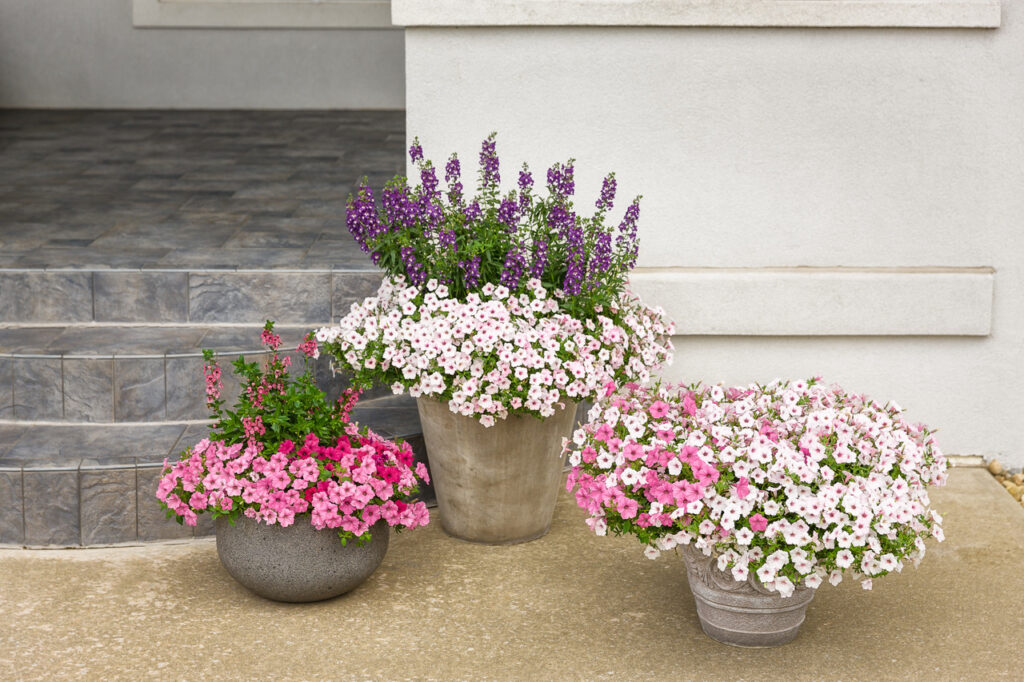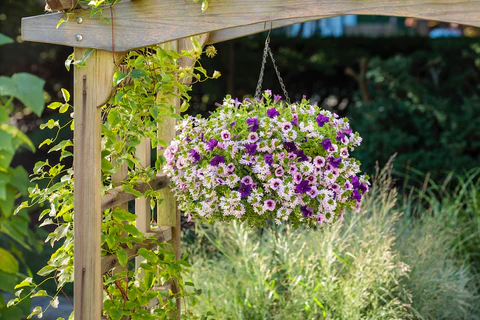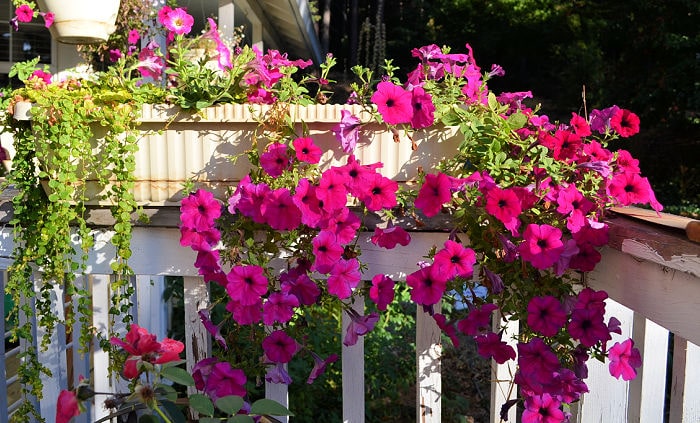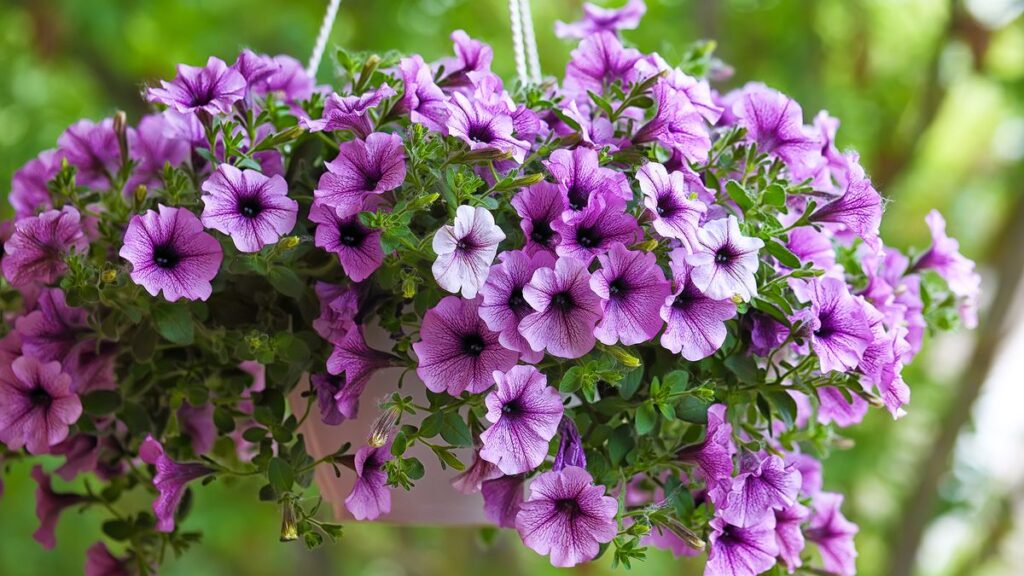Petunias are sunshine in bloom, a bright splash of color that brightens balconies and gardens around. However, these sun-loving charmers are not immune to difficulties. The ten essential traits of petunias—both standard and Supertunia varieties—will be revealed in this guide, equipping you to handle any issues that may crop up and establish a flourishing floral sanctuary.
The truth is, although both petunias and Supertunias have gorgeous blossoms, they are different from one another. We’ll look at their growth patterns, ability to bloom, upkeep requirements, and even pricing ranges so you can select the ideal flowering companion for your garden and take care of any potential issues before they arise!
Related Blog:
| Feature | Supertunia | Regular Petunia |
|---|---|---|
| Type | Trailing/mounding | Bushy/upright |
| Propagation | Cuttings | Seeds |
| Flowering | Massive | Good |
| Flower Size | Large (varies) | Small |
| Maintenance | Low (self-cleaning) | High (needs deadheading) |
| Fertilizer | Frequent | Occasional |
| Sun | Full sun (tolerates some shade) | Full sun |
| Disease Resistance | High | Low |
| Seed Production | No | Yes |
| Price | High | Low |
Supertunia
Proven Winners® Supertunias® are a newer breed of petunias that are available in a wide array of colors in both single and double blooms. Petunia Supertunia® are developed from cuttings, not seed.With its brilliant blooms and captivating cascading presence, the Supertunia is a flowering supernova that completely changes patios and gardens.The Proven Winners® petunias are more floriferous because all their energy is put into flower production, not seed production. Petunia Supertunia® generally stand around 6- 10 inches tall and can spread/trail up to 24-36 inches, But what distinguishes them from their cousins the petunias specifically? Now let’s explore the ten distinct qualities that make Supertunias an essential plant for any gardener.
1-Bountiful Mound
Supertunias have two basic growth habits: trailing and mounding. Regular petunias usually grow in a compact, bushy form. With their long branches brimming with blooms that produce an amazing cascade of color, trailing types are ideal for window boxes and hanging baskets. Conversely, Supertunias that mound up are perfect for covering planters and raised beds. They burst forth in a flurry of flowers, creating a colorful, thick mound that brings vitality to any area.

2-Clones of Perfection
The method used to grow supertunias through cuttings guarantees that every plant is a genetic duplicate of its parent plant. This implies that you can be sure that every Supertunia you purchase will have the same gorgeous bloom size, color, and cascading habit as the one that wowed you at the nursery. Supertunias promise a display of guaranteed floral uniformity, unlike petunias grown from seeds, which may show subtle differences.
3-A Non-Stop Floral Extravaganza
Get ready for an abundant display of flowers! Supertunias are renowned for producing flowers nonstop. These industrious workers will yield an astounding quantity of flowers all through the growing season. Imagine a visual feast that would make your neighbors green with envy and make you smile every morning when you wake up to overflowing baskets or containers bursting with color.
4-Large, Vibrant, and Stunning Blooms
Supertunias frequently go over and above the usual petunia size range. Their blooms can be substantially larger than those of ordinary petunias, depending on the particular variety. This results in a more striking visual impact. Imagine the difference between ornate dinner plates and dainty teacups; that is the kind of floral statement that Supertunias can create in your landscape.
5-Low-maintenance
Supertunias are your new best buddies if you’re a busy gardener with little time for flower care. They’re low-maintenance magic. Supertunias essentially clean themselves, in contrast to conventional petunias, which need to have spent blooms removed on a regular basis in order to promote more flowering. Deadheading is not necessary because they constantly produce new blooms that push out the old ones. This means you’ll have less work to do and more time to just take in the beauty of your flowers.
6-Feeding the Floral Frenzy
Supertunias are heavy feeders despite needing little upkeep. For them to keep their vivid colors and cascading form during their prolific flowering, a consistent supply of fertilizers is needed. They will remain content and produce their biggest flowers of the season with regular treatment using a balanced fertilizer. Consider it as fuel for their flower factory; a little additional care for these vibrant bloomers goes a long way.

7-Sun- Tolerance
When given at least six hours of direct sunshine per day, supertunias flourish in full sun. In addition to ensuring brilliant flower colors, this enables them to generate as many blossoms as possible. They are not, however, total sun snobs. Supertunias can withstand a few hours of afternoon shadow, which makes them adaptable to a wider range of garden conditions than many plants that wilt at the first hint of shade.
8-A Built-in Protector
Supertunias typically exhibit higher disease resistance than standard petunias. This implies that common flower diseases like botrytis and powdery mildew will not affect them as much. This results in plants that are healthier and require less fungicide intervention. You may enjoy the vivid display of your Supertunias for longer and worry less about illnesses.
9-Beauty Without Seeds
Because supertunias are sterile, they are incapable of producing seeds. This offers two benefits. Initially, it enables the plant to focus all of its energy on creating more and larger blooms. Secondly, it gets rid of the chance of unwelcome volunteers showing up in your flower beds. Supertunias provide a guaranteed show of flawless flowers without the mess of seeds, while some gardeners relish the challenge of seed propagation.
Regular petunias
Regular petunias are often overlooked in favour of their more showy Supertunia cousins, but they are nonetheless valuable summer garden staples. With a blend of charm, affordability, and low maintenance requirements, these happy bloomers have a distinct personality that makes them ideal for gardeners of all skill levels. Let’s explore the ten qualities that normal petunias have that make them a lovely addition to any garden.

1-Height
Regular petunias grow bushy and upright, in contrast to Supertunias’ cascading tendencies. This makes them perfect for adding color to garden areas, delineating boundaries, and bordering walks. Imagine a line of petunias, their blossoms creating a vibrant border that greets you as you approach your garden haven, standing soldier straight.
2-Colors
Standard petunias provide a surprisingly wide range of colours. Petunias grown from seeds may have modest variations in flower size, shape, and even color, unlike genetically identical Supertunias. This gives your garden a unique and charming touch. It’s similar to having a bunch of pals, each adding to the lively and happy atmosphere with their own distinct personalities.
3-Blooms
Regular petunias aren’t exactly as prolific as Supertunias, but they’re still really good bloomers. They’ll provide a constant flow of lovely blooms all growing season long, turning your yard into a rainbow. While they might not be a constant floral spectacular, they do provide a dependable and charming arrangement that will make your day.
4-Petite Powerhouses
Don’t be fooled by normal petunia blossoms’ little size. They are available in a wide range of vivid hues, from traditional pinks and purples to upbeat yellows and flaming reds. They may be crammed closer together because to their small size, which results in a display that is dense and vibrantly coloured. Consider them as vibrant jewels enhancing your landscape, each one with a distinct personality despite their little size.
5-Maintenance
Supertunias require less upkeep than regular petunias, which need a little more. You will need to practice deadheading, which is just pulling spent flowers off the plant, in order to promote continuous flowering. Although it could seem like a chore, the process is easy and gratifying. Deadheading allows you to take part in your garden’s cycle of development and rejuvenation while also getting up close and personal with the beauty of the flowers.
6-Fertilization
Regular petunias require occasional fertilization, although they are not as heavy feeders as Supertunias. They will get the nutrients they require from a balanced fertilizer to support healthy growth and create those stunning flowers. Consider it as a vitamin boost to keep your petunias healthy all season long.
7-Sun Tolerance
Like their cousins the Supertunias, regular petunias are sun worshipers. Planting them where they will receive at least six hours of direct sunlight per day will maximize their performance. This guarantees the best possible development and vivid blossom colors. However, if your garden isn’t exposed to full sun all day, don’t worry. Because they can withstand some afternoon shadow, petunias are versatile in a range of garden settings.

8-One Blossom at a Time
Common petunias may be vulnerable to specific ailments such as powdery mildew, a white fungal development on foliage. To maintain the health of your petunias, you can take certain preventative steps. Utilizing organic pest control measures, adequate ventilation, and appropriate watering techniques (avoid overhead watering) can all help lower the risk of illness.
9-The Present That Just Keeps Giving (Perhaps)
Regular petunias yield seeds; sterile Supertunias do not. This enables you to save the seeds from your most beloved flowers and sow them again the next year. It’s an inexpensive and enjoyable method to grow your collection of petunias and enjoy the satisfaction of bringing fresh life into your yard. However, be aware that due to genetic variation, seedlings developed from seeds may not be exactly like the parent plant.


